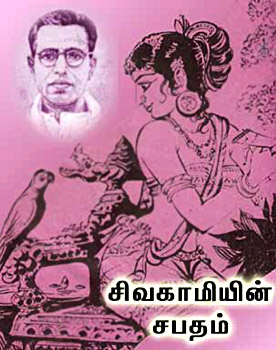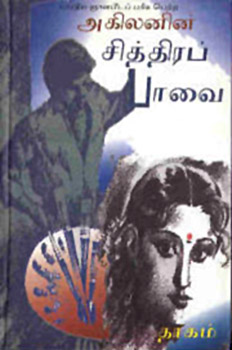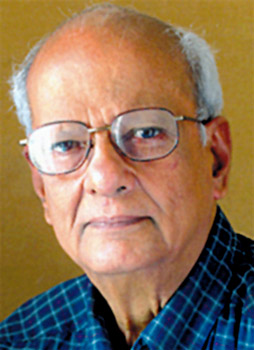Novel in twentieth century Tamil literature had already developed deep roots. The earliest refined works in novel writing began in the nineteenth century with the works of Veda Nayakam Pillai. He was the author of the first Tamil novel, called Pratapa Mudaliyar Chariththiram (The Story of Pratapa Mudaliyar), which was published in 1876. Since then, novels have flourished in a big way in Tamil literature. In the early part of the twentieth century, authors like Vaduvur Dorai Swamy Iyengar, Arani Kuppu Swamy Mudaliyar and K. R. Ranga Raju wrote countless tales of mystery and imagination full of suspense and unique ways of detection. Sadly, most of them were imitations or adaptations of English detective novels. By the mid-1950s, however, talented writers like Chiranjeevi, Devan and Tamizh Vanan began to turn out quality detective fiction in Tamil with originality and sophistication. The 1970s yielded a major writer of mesmerizing detective fiction in Sujatha. Freely borrowing and adapting English expressions and motifs in his tales, such as Nylon Kaiyiru (Nylon Rope), Gayathri, and Kanavuth Thozhirtchchalai (Dream Factory), Sujatha managed to infuse a tremendous excitement into his stories. Soon, he became the idol of young readers who liked fast-paced stories that kept them on the edge of their seats. He retains that enviable status to this day.
 Apart from fiction, a number of other themes in Tamil novels also find a popular audience in Tamil literature. Tamil novels that focus on Social Realism portray realistic characters and focus on their daily problems and conflicts. They thus create an atmosphere of authenticity. Some of these novels are openly didactic, while others are satiric and reformist in content and intention. Kalki (1899-1954) occupies a unique place in the world of the Tamil novel of social realism. The early decades of the twentieth century were very realistically portrayed in his masterpieces Thyaga Bhoomi (The Land of Sacrifice, 1938-39) and Alai Osai (The Sound of Waves, 1948-49). The freedom struggle was depicted so graphically in Thyaga Bhoomi that it was banned for its provocative political ideas by the British Raj. In fact, Kalki has displayed great skill in including a number of historic events connected with the Indian struggle for independence into his social novels. These include events such as the Sepoy mutiny (1857), the Non-Cooperation Movement (1929), the Salt Satyagraha (1930), the Gandhi-Irwin Pact (1931), the Second Roundtable Conference (1931), the arrest of Gandhi and Nehru (1931), the Quit India movement (1942), the Independence Day celebrations (1947), the Hindu-Muslim conflict subsequent to partition (1947-48), and the assassination of Mahatma Gandhi (1948).
Apart from fiction, a number of other themes in Tamil novels also find a popular audience in Tamil literature. Tamil novels that focus on Social Realism portray realistic characters and focus on their daily problems and conflicts. They thus create an atmosphere of authenticity. Some of these novels are openly didactic, while others are satiric and reformist in content and intention. Kalki (1899-1954) occupies a unique place in the world of the Tamil novel of social realism. The early decades of the twentieth century were very realistically portrayed in his masterpieces Thyaga Bhoomi (The Land of Sacrifice, 1938-39) and Alai Osai (The Sound of Waves, 1948-49). The freedom struggle was depicted so graphically in Thyaga Bhoomi that it was banned for its provocative political ideas by the British Raj. In fact, Kalki has displayed great skill in including a number of historic events connected with the Indian struggle for independence into his social novels. These include events such as the Sepoy mutiny (1857), the Non-Cooperation Movement (1929), the Salt Satyagraha (1930), the Gandhi-Irwin Pact (1931), the Second Roundtable Conference (1931), the arrest of Gandhi and Nehru (1931), the Quit India movement (1942), the Independence Day celebrations (1947), the Hindu-Muslim conflict subsequent to partition (1947-48), and the assassination of Mahatma Gandhi (1948).
No other writer of historical novels in Tamil handled famous characters and poignant themes from the rich Tamilian cultural heritage so brilliantly and movingly as Kalki. His epic depictions of the great Mahendra Varma Pallava and his illustrious son Narasimha Varma Pallava in Sivakamiyin Sabadam and Parthiban Kanavu (Parthiban`s Dream, 1941-43), as well as his monumental odyssey of the young Raja Raja to the Chozha throne in Ponniyin Chelvan (The Beloved Offspring of the River Ponni, 1950-54), are enduring historical romances that bring to life the splendor of the Pallava and Chozha kingdoms of bygone ages and have thus come to dominate the Tamilian imagination.
 In the post-Independent era, Akilan stands foremost among the novelists who captivated the reading public. Novel after novel of Akilan won a prestigious award. Perm (Woman) won the Narayana Swamy Iyer Prize, and Nenjin Alaigal (The Waves of the Mind) won the Tamil Valarchi Kazhagam`s Prize. Chiththirap Pavai (The Picturesque Woman) obtained the Gnana Peedam Prize, while Pavai Vilakku (The Lamp of the Lady) gained national recognition by securing the Sahithya Akademi Award. The reason behind Akilan`s outstanding success was the fact that he created rather arresting characters and plots with a straightforward but rather enchanting style. He was very skillfully able to infuse rather lofty ideals into his narratives without compromising on their realism. Akilan was second only to Kalki in the depiction of historical themes in his works. His gripping rendition of the times of the conqueror and administrator Rajendra Chozha in Vengaiyin Maindan (The Tiger`s Son) also won him the Sahitya Akademi Award. The magnificence of the Vijaya Nagara Empire comes thrillingly to life in another of his novels called Vetrith Thiru Nagar (Vijaya Nagara, the City of Victory).
In the post-Independent era, Akilan stands foremost among the novelists who captivated the reading public. Novel after novel of Akilan won a prestigious award. Perm (Woman) won the Narayana Swamy Iyer Prize, and Nenjin Alaigal (The Waves of the Mind) won the Tamil Valarchi Kazhagam`s Prize. Chiththirap Pavai (The Picturesque Woman) obtained the Gnana Peedam Prize, while Pavai Vilakku (The Lamp of the Lady) gained national recognition by securing the Sahithya Akademi Award. The reason behind Akilan`s outstanding success was the fact that he created rather arresting characters and plots with a straightforward but rather enchanting style. He was very skillfully able to infuse rather lofty ideals into his narratives without compromising on their realism. Akilan was second only to Kalki in the depiction of historical themes in his works. His gripping rendition of the times of the conqueror and administrator Rajendra Chozha in Vengaiyin Maindan (The Tiger`s Son) also won him the Sahitya Akademi Award. The magnificence of the Vijaya Nagara Empire comes thrillingly to life in another of his novels called Vetrith Thiru Nagar (Vijaya Nagara, the City of Victory).
Partha Sarathy`s Kurinchi Malar (The Rarest Flower) and Indira Partha Sarathy`s Kurudhip Punal (Blood Stream) are two post-independence novels memorable for their characterization and plot. Among the later novelists, Balakumaran is noteworthy. Serialized simultaneously in several popular Tamil magazines, his novels, such as Irandavathu Suryan (The Second Sun), Payanikal Gavanickavum (Travelers, Watch Out!), and Thoppul Kodi (Umbilical Cord), have become immensely popular.
 Among the novels that concentrate on a particular region of Tamil Nadu and bring its speech and culture to life, Koththa Mangalam Subbu`s masterpiece Thillana Mohanambal (Mohanambal the Unique Dancer of Thillana) and K. Raja Narayanan`s magnum opus Gopalla Puraththu Makkal (The People of Gopalla Puram) are outstanding. While Subbu`s novel captures the picturesque lifestyle that prevailed in the pre-independence Tanjore district of Tamil Nadu, Raja Narayanan`s saga relates the deprivations and fulfillments of ordinary villagers in the dry districts of present-day Tamil Nadu. Among later works, Jayamohan`s novel Rubber, which won the Akilan Memorial Prize in 1990, is outstanding for its graphic depiction of the agrarian community in South India. When the community abandons its long-standing traditional crop of plantains and cultivates rubber trees, unsuited to the climate and environment, disaster follows. The novel thus emphasises the importance of living in tune with nature.
Among the novels that concentrate on a particular region of Tamil Nadu and bring its speech and culture to life, Koththa Mangalam Subbu`s masterpiece Thillana Mohanambal (Mohanambal the Unique Dancer of Thillana) and K. Raja Narayanan`s magnum opus Gopalla Puraththu Makkal (The People of Gopalla Puram) are outstanding. While Subbu`s novel captures the picturesque lifestyle that prevailed in the pre-independence Tanjore district of Tamil Nadu, Raja Narayanan`s saga relates the deprivations and fulfillments of ordinary villagers in the dry districts of present-day Tamil Nadu. Among later works, Jayamohan`s novel Rubber, which won the Akilan Memorial Prize in 1990, is outstanding for its graphic depiction of the agrarian community in South India. When the community abandons its long-standing traditional crop of plantains and cultivates rubber trees, unsuited to the climate and environment, disaster follows. The novel thus emphasises the importance of living in tune with nature.
Several women writers too have contributed to the growth of the Tamil novel. The works of Anuththama, such as Oru Veedu (A Home), Ketta Varam (The Sought-After Boon), and Manal Veedu (House of Sand), and of Lakshmi, such as Penn Manam (Woman`s Heart), Kanchanaiyin Kanavu (Kanchanai`s Dream), and Aththai (Aunt), revolve around domestic problems and emphasize values of love and self-sacrifice as means of resolution. Rajam Krishnan`s novels often investigate unexplored sections of Tamil society. For instance, her Kurinchith Then (The Rarest Honey) focuses on an aboriginal tribe of Tamil Nadu and deals with the conflicts they experience between their age-old traditions and modern innovations. Siva Sankari is another unusual novelist who handles controversial yet timely ideas in her works. For example, her novel Avan Aval Adhu (He She It) deals with artificial insemination and shows how it plays havoc with the peace and harmony of a typical south Indian family.
Prapanjan`s award-winning Manutam Vellum (Humankind Will Triumph) is a notable achievement in the realm of later historical novels. Based on the diaries of Anandarangam Pillai, a translator in Pondicherry under General Dupleix, governor of French colonial possessions, the novel depicts in fascinating detail the daily challenges and changes of living in eighteenth-century India.
Thus the novels in Tamil literature have covered extensive ground in the twentieth century and continue to develop and advance in the contemporary era.













